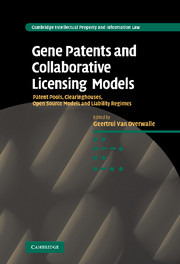 Gene Patents and Collaborative Licensing Models
Gene Patents and Collaborative Licensing Models Book contents
- Frontmatter
- Contents
- List of contributors
- Preface
- Foreword: Jean-Jacques Cassiman
- List of abbreviations
- Part I Patent pools
- Part II Clearinghouses
- Part III Open source models
- Part IV Liability regimes
- Part V Different perspectives
- 20 Gene patents: from discovery to invention. A geneticist's view
- 21 ‘Patent tsunami’ in the field of genetic diagnostics. A patent practitioner's view
- 22 Gene patents and clearing models. Some comments from a competition law perspective
- 23 Access to genetic patents and clearing models. An economic perspective
- 24 The role of law, institutions and governance in facilitating access to the scientific research commons. A philosopher's perspective
- Part VI Summary and concluding analysis
- Index
- Titles in the series
22 - Gene patents and clearing models. Some comments from a competition law perspective
from Part V - Different perspectives
Published online by Cambridge University Press: 14 January 2010
- Frontmatter
- Contents
- List of contributors
- Preface
- Foreword: Jean-Jacques Cassiman
- List of abbreviations
- Part I Patent pools
- Part II Clearinghouses
- Part III Open source models
- Part IV Liability regimes
- Part V Different perspectives
- 20 Gene patents: from discovery to invention. A geneticist's view
- 21 ‘Patent tsunami’ in the field of genetic diagnostics. A patent practitioner's view
- 22 Gene patents and clearing models. Some comments from a competition law perspective
- 23 Access to genetic patents and clearing models. An economic perspective
- 24 The role of law, institutions and governance in facilitating access to the scientific research commons. A philosopher's perspective
- Part VI Summary and concluding analysis
- Index
- Titles in the series
Summary
Introduction
Competition law is not at the centre of the present book. It comes in as an additional concern, influencing the search for proper models for solving a problem of patent abundance, whose contours, however, are not yet well realized and recognized in biotechnology. Like in other areas of advanced technologies, the basic assumption is that the field is crowded by a large number of patents, with ownership being dispersed among many patentees, so that it becomes impossible for anyone to work naturally coherent pieces of the technology without first obtaining consent by many other patentees. Seeking such consent may delay innovation, and raise its costs as royalties may have to be paid. It also entails transactions costs relating to the search of relevant patents and patentees, to determining the patents' value, and to negotiating license agreements, provided always that an agreement may be found.
In the present volume, a large variety of models has been presented, which either seek to avoid or to overcome the problem resulting from the fragmentation of technologies into pieces of proprietary knowledge. In a competition law perspective, this by itself represents quite a remarkable merit of this volume, since it opens the view for a number of options among which to choose when looking for a “pro-competitive” or, at least, for a non anticompetitive solution of the problem. However, for the commentator, it creates an embarras de richesse.
- Type
- Chapter
- Information
- Gene Patents and Collaborative Licensing ModelsPatent Pools, Clearinghouses, Open Source Models and Liability Regimes, pp. 339 - 349Publisher: Cambridge University PressPrint publication year: 2009
- 2
- Cited by


